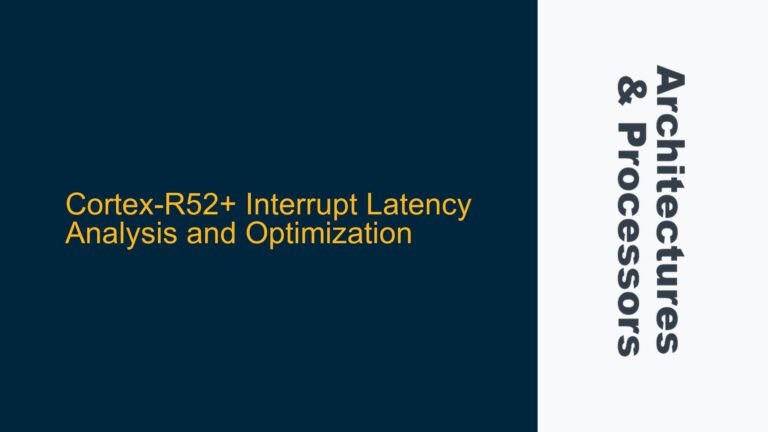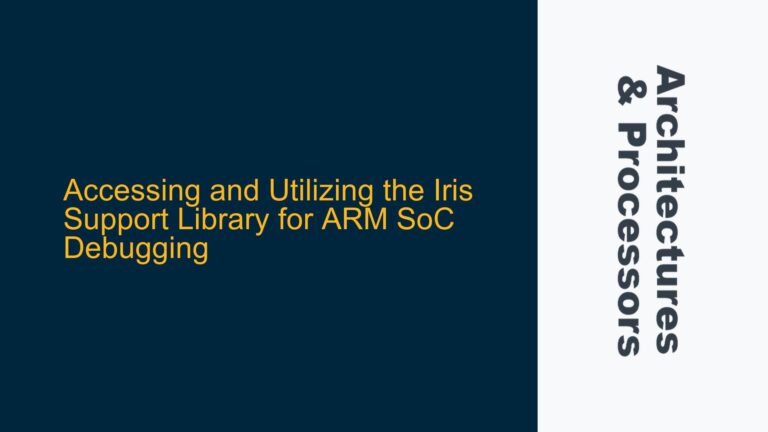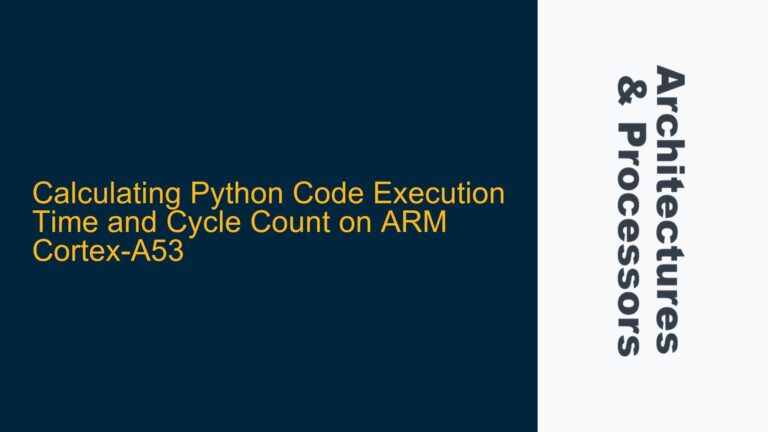ARM Cortex-A53 and Cortex-A9 PMU Architecture and Core-Specific Event Monitoring
The Performance Monitoring Unit (PMU) in ARM Cortex-A53 and Cortex-A9 processors is a critical component for profiling and optimizing system performance. The PMU provides hardware counters that allow developers to monitor various microarchitectural events, such as cache hits/misses, branch predictions, and instruction execution counts. Understanding the architecture of the PMU, particularly whether it is shared across cores or dedicated per core, is essential for accurate performance analysis and debugging. In the Cortex-A53 and Cortex-A9, the PMU is designed to be core-specific, meaning each core has its own dedicated PMU. This design choice ensures that performance metrics are isolated to individual cores, enabling precise analysis of core-specific behavior.
The Cortex-A53 PMU, for instance, supports a wide range of events, including cycle counts, instruction retirements, and memory system transactions. Each PMU is integrated into the core complex, allowing it to monitor events that are local to the core, such as L1 cache accesses and TLB operations. Similarly, the Cortex-A9 PMU is embedded within each core, providing visibility into core-specific events like pipeline stalls and branch mispredictions. This per-core PMU architecture is critical for multi-core systems, where shared PMUs would aggregate events across cores, making it difficult to isolate performance bottlenecks or identify core-specific inefficiencies.
The Technical Reference Manual (TRM) for both processors, while not explicitly stating the per-core nature of the PMU, implies this configuration through the description of PMU registers and event counters. For example, the Cortex-A9 TRM describes the PMU as part of the "core complex," suggesting that each core has its own PMU instance. This design is further supported by the nature of the events being monitored, such as L1 cache accesses, which are inherently core-specific and would not make sense if aggregated across multiple cores.
Implications of Shared vs. Dedicated PMUs in Multi-Core Systems
The distinction between shared and dedicated PMUs has significant implications for performance analysis in multi-core systems. A shared PMU architecture, where a single PMU is used across multiple cores, would require complex event routing and multiplexing logic to ensure that events from different cores are correctly attributed. This approach would introduce additional latency and complexity, potentially skewing performance measurements. Moreover, shared PMUs would struggle to provide accurate insights into core-specific behavior, as events from multiple cores would be interleaved or aggregated.
In contrast, the dedicated PMU architecture used in Cortex-A53 and Cortex-A9 processors ensures that each core’s performance metrics are isolated and accurate. This isolation is particularly important for debugging and optimizing multi-threaded applications, where performance bottlenecks may be localized to a specific core. For example, if one core is experiencing frequent L1 cache misses due to a poorly optimized memory access pattern, a dedicated PMU would allow developers to identify and address this issue without interference from other cores.
The dedicated PMU architecture also simplifies the implementation of performance monitoring tools and frameworks. Tools like Linux perf can leverage the per-core PMU to collect detailed performance data for each core, enabling fine-grained analysis and optimization. This capability is especially valuable in heterogeneous multi-core systems, where different cores may have different performance characteristics and optimization requirements.
Configuring and Utilizing PMUs for Accurate Performance Analysis
To effectively utilize the PMUs in Cortex-A53 and Cortex-A9 processors, developers must understand how to configure and access the PMU registers. Each PMU provides a set of configurable counters that can be programmed to monitor specific events. For example, in the Cortex-A53, the PMU includes six configurable counters, each of which can be programmed to count events such as instruction retirements, cache accesses, or branch mispredictions. Similarly, the Cortex-A9 PMU provides four configurable counters, along with a fixed-cycle counter that increments with each clock cycle.
Configuring the PMU involves writing to the Performance Monitor Control Register (PMCR) and the Event Selection Registers (PMSELR). The PMCR is used to enable or disable the PMU, reset the counters, and set the clock divider for the cycle counter. The PMSELR is used to select the event to be monitored by each counter. For example, to monitor L1 data cache accesses on a Cortex-A53 core, developers would write the appropriate event code to the PMSELR and enable the corresponding counter in the PMCR.
Once the PMU is configured, developers can read the counter values to analyze performance. The counters can be accessed through the Performance Monitor Count Registers (PMCCNTR), which store the current count for each event. By periodically reading these registers, developers can track the occurrence of specific events over time and identify performance trends or anomalies.
In addition to configuring the PMU, developers must also consider the impact of context switching and multi-threading on performance monitoring. When a context switch occurs, the PMU counters may continue to accumulate events for the new thread, potentially skewing the results. To address this issue, developers can use the PMU’s overflow interrupt feature, which triggers an interrupt when a counter exceeds a specified threshold. This feature allows developers to pause the counters during context switches and resume them when the original thread is restored.
Practical Considerations for PMU-Based Performance Optimization
While the PMU provides valuable insights into system performance, there are several practical considerations that developers must keep in mind when using it for optimization. First, the PMU counters have a limited width, typically 32 or 64 bits, which means they can overflow if not read frequently enough. To prevent overflow, developers should configure the PMU to generate an interrupt when a counter approaches its maximum value. This interrupt can be used to read and reset the counter, ensuring that performance data is not lost.
Second, the PMU can introduce overhead, particularly when monitoring a large number of events or running at high frequencies. This overhead can affect the accuracy of performance measurements, especially in real-time systems where timing is critical. To minimize overhead, developers should carefully select the events to be monitored and avoid enabling unnecessary counters. Additionally, developers can use the PMU’s clock divider feature to reduce the frequency at which the cycle counter increments, thereby reducing overhead.
Finally, developers should be aware of the limitations of the PMU in terms of event coverage. While the PMU provides a wide range of events, it may not cover all aspects of system performance. For example, the PMU may not provide direct visibility into interconnect or memory controller activity, which can also impact performance. In such cases, developers may need to use additional tools or techniques, such as bus analyzers or simulation models, to complement the PMU data.
Conclusion
The Performance Monitoring Unit (PMU) in ARM Cortex-A53 and Cortex-A9 processors is a powerful tool for profiling and optimizing system performance. By providing core-specific event counters, the PMU enables developers to gain detailed insights into the behavior of individual cores, making it easier to identify and address performance bottlenecks. However, to fully leverage the PMU, developers must understand its architecture, configuration, and limitations. By following best practices for PMU usage, developers can ensure accurate performance analysis and achieve optimal system performance.






